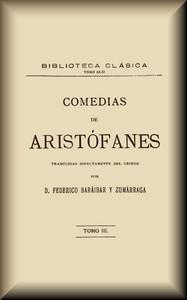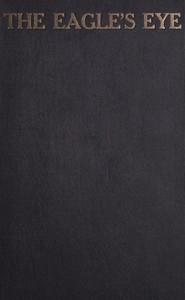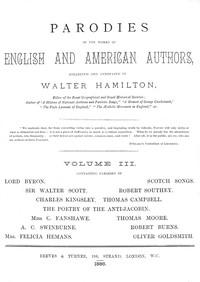|
|
Read this ebook for free! No credit card needed, absolutely nothing to pay.Words: 57934 in 106 pages
This is an ebook sharing website. You can read the uploaded ebooks for free here. No credit cards needed, nothing to pay. If you want to own a digital copy of the ebook, or want to read offline with your favorite ebook-reader, then you can choose to buy and download the ebook.

: Comedias tomo 3 de 3 by Aristophanes BCE BCE Bar Ibar Y Zum Rraga Federico Translator - Athens (Greece) Drama; Aristophanes Translations into Spanish; Greek drama (Comedy) Translations into Spanish@FreeBooksThu 08 Jun, 2023 THE NUMBER CONCEPT: ITS ORIGIN AND DEVELOPMENT. COUNTING. Among the speculative questions which arise in connection with the study of arithmetic from a historical standpoint, the origin of number is one that has provoked much lively discussion, and has led to a great amount of learned research among the primitive and savage languages of the human race. A few simple considerations will, however, show that such research must necessarily leave this question entirely unsettled, and will indicate clearly that it is, from the very nature of things, a question to which no definite and final answer can be given. These facts must of necessity deter the mathematician from seeking to push his investigation too far back toward the very origin of number. Philosophers have endeavoured to establish certain propositions concerning this subject, but, as might have been expected, have failed to reach any common ground of agreement. Whewell has maintained that "such propositions as that two and three make five are necessary truths, containing in them an element of certainty beyond that which mere experience can give." Mill, on the other hand, argues that any such statement merely expresses a truth derived from early and constant experience; and in this view he is heartily supported by Tylor. But why this question should provoke controversy, it is difficult for the mathematician to understand. Either view would seem to be correct, according to the standpoint from which the question is approached. We know of no language in which the suggestion of number does not appear, and we must admit that the words which give expression to the number sense would be among the early words to be formed in any language. They express ideas which are, at first, wholly concrete, which are of the greatest possible simplicity, and which seem in many ways to be clearly understood, even by the higher orders of the brute creation. The origin of number would in itself, then, appear to lie beyond the proper limits of inquiry; and the primitive conception of number to be fundamental with human thought. Many writers do not agree with the conclusions which Lubbock reaches; maintaining that there is, in all such instances, a perception of greater or less quantity rather than any idea of number. But a careful consideration of the objections offered fails entirely to weaken the argument. Example after example of a nature similar to those just quoted might be given, indicating on the part of animals a perception of the difference between 1 and 2, or between 2 and 3 and 4; and any reasoning which tends to show that it is quantity rather than number which the animal perceives, will apply with equal force to the Demara, the Chiquito, and the Australian. Hence the actual origin of number may safely be excluded from the limits of investigation, and, for the present, be left in the field of pure speculation. A most inviting field for research is, however, furnished by the primitive methods of counting and of giving visible expression to the idea of number. Our starting-point must, of course, be the sign language, which always precedes intelligible speech; and which is so convenient and so expressive a method of communication that the human family, even in its most highly developed branches, never wholly lays it aside. It may, indeed, be stated as a universal law, that some practical method of numeration has, in the childhood of every nation or tribe, preceded the formation of numeral words. At first thought there would seem to be no good reason for any marked uniformity of method in finger counting. Observation among children fails to detect any such thing; the child beginning, with almost entire indifference, on the thumb or on the little finger of the left hand. My own observation leads to the conclusion that very young children have a slight, though not decided preference for beginning with the thumb. Experiments in five different primary rooms in the public schools of Worcester, Mass., showed that out of a total of 206 children, 57 began with the little finger and 149 with the thumb. But the fact that nearly three-fourths of the children began with the thumb, and but one-fourth with the little finger, is really far less significant than would appear at first thought. Children of this age, four to eight years, will count in either way, and sometimes seem at a loss themselves to know where to begin. In one school room where this experiment was tried the teacher incautiously asked one child to count on his fingers, while all the other children in the room watched eagerly to see what he would do. He began with the little finger--and so did every child in the room after him. In another case the same error was made by the teacher, and the child first asked began with the thumb. Every other child in the room did the same, each following, consciously or unconsciously, the example of the leader. The results from these two schools were of course rejected from the totals which are given above; but they serve an excellent purpose in showing how slight is the preference which very young children have in this particular. So slight is it that no definite law can be postulated of this age; but the tendency seems to be to hold the palm of the hand downward, and then begin with the thumb. The writer once saw a boy about seven years old trying to multiply 3 by 6; and his method of procedure was as follows: holding his left hand with its palm down, he touched with the forefinger of his right hand the thumb, forefinger, and middle finger successively of his left hand. Then returning to his starting-point, he told off a second three in the same manner. This process he continued until he had obtained 6 threes, and then he announced his result correctly. If he had been a few years older, he might not have turned so readily to his thumb as a starting-point for any digital count. The indifference manifested by very young children gradually disappears, and at the age of twelve or thirteen the tendency is decidedly in the direction of beginning with the little finger. Fully three-fourths of all persons above that age will be found to count from the little finger toward the thumb, thus reversing the proportion that was found to obtain in the primary school rooms examined. With respect to finger counting among civilized peoples, we fail, then, to find any universal law; the most that can be said is that more begin with the little finger than with the thumb. But when we proceed to the study of this slight but important particular among savages, we find them employing a certain order of succession with such substantial uniformity that the conclusion is inevitable that there must lie back of this some well-defined reason, or perhaps instinct, which guides them in their choice. This instinct is undoubtedly the outgrowth of the almost universal right-handedness of the human race. In finger counting, whether among children or adults, the beginning is made on the left hand, except in the case of left-handed individuals; and even then the start is almost as likely to be on the left hand as on the right. Savage tribes, as might be expected, begin with the left hand. Not only is this custom almost invariable, when tribes as a whole are considered, but the little finger is nearly always called into requisition first. To account for this uniformity, Lieutenant Gushing gives the following theory, which is well considered, and is based on the results of careful study and observation among the Zu?i Indians of the Southwest: "Primitive man when abroad never lightly quit hold of his weapons. If he wanted to count, he did as the Zu?i afield does to-day; he tucked his instrument under his left arm, thus constraining the latter, but leaving the right hand free, that he might check off with it the fingers of the rigidly elevated left hand. From the nature of this position, however, the palm of the left hand was presented to the face of the counter, so that he had to begin his score on the little finger of it, and continue his counting from the right leftward. An inheritance of this may be detected to-day in the confirmed habit the Zu?i has of gesticulating from the right leftward, with the fingers of the right hand over those of the left, whether he be counting and summing up, or relating in any orderly manner." Here, then, is the reason for this otherwise unaccountable phenomenon. If savage man is universally right-handed, he will almost inevitably use the index finger of his right hand to mark the fingers counted, and he will begin his count just where it is most convenient. In his case it is with the little finger of the left hand. In the case of the child trying to multiply 3 by 6, it was with the thumb of the same hand. He had nothing to tuck under his arm; so, in raising his left hand to a position where both eye and counting finger could readily run over its fingers, he held the palm turned away from his face. The same choice of starting-point then followed as with the savage--the finger nearest his right hand; only in this case the finger was a thumb. The deaf mute is sometimes taught in this manner, which is for him an entirely natural manner. A left-handed child might be expected to count in a left-to-right manner, beginning, probably, with the thumb of his right hand. To the law just given, that savages begin to count on the little finger of the left hand, there have been a few exceptions noted; and it has been observed that the method of progression on the second hand is by no means as invariable as on the first. The Otomacs of South America began their count with the thumb, and to express the number 3 would use the thumb, forefinger, and middle finger. The Maipures, oddly enough, seem to have begun, in some cases at least, with the forefinger; for they are reported as expressing 3 by means of the fore, middle, and ring fingers. The Andamans begin with the little finger of either hand, tapping the nose with each finger in succession. If they have but one to express, they use the forefinger of either hand, pronouncing at the same time the proper word. The Bahnars, one of the native tribes of the interior of Cochin China, exhibit no particular order in the sequence of fingers used, though they employ their digits freely to assist them in counting. Among certain of the negro tribes of South Africa the little finger of the right hand is used for 1, and their count proceeds from right to left. With them, 6 is the thumb of the left hand, 7 the forefinger, and so on. They hold the palm downward instead of upward, and thus form a complete and striking exception to the law which has been found to obtain with such substantial uniformity in other parts of the uncivilized world. In Melanesia a few examples of preference for beginning with the thumb may also be noticed. In the Banks Islands the natives begin by turning down the thumb of the right hand, and then the fingers in succession to the little finger, which is 5. This is followed by the fingers of the left hand, both hands with closed fists being held up to show the completed 10. In Lepers' Island, they begin with the thumb, but, having reached 5 with the little finger, they do not pass to the other hand, but throw up the fingers they have turned down, beginning with the forefinger and keeping the thumb for 10. In the use of the single hand this people is quite peculiar. The second 5 is almost invariably told off by savage tribes on the second hand, though in passing from the one to the other primitive man does not follow any invariable law. He marks 6 with either the thumb or the little finger. Probably the former is the more common practice, but the statement cannot be made with any degree of certainty. Among the Zulus the sequence is from thumb to thumb, as is the case among the other South African tribes just mentioned; while the Veis and numerous other African tribes pass from thumb to little finger. The Eskimo, and nearly all the American Indian tribes, use the correspondence between 6 and the thumb; but this habit is by no means universal. Respecting progression from right to left or left to right on the toes, there is no general law with which the author is familiar. Many tribes never use the toes in counting, but signify the close of the first 10 by clapping the hands together, by a wave of the right hand, or by designating some object; after which the fingers are again used as before. One other detail in finger counting is worthy of a moment's notice. It seems to have been the opinion of earlier investigators that in his passage from one finger to the next, the savage would invariably bend down, or close, the last finger used; that is, that the count began with the fingers open and outspread. This opinion is, however, erroneous. Several of the Indian tribes of the West begin with the hand clenched, and open the fingers one by one as they proceed. This method is much less common than the other, but that it exists is beyond question. In the Muralug Island, in the western part of Torres Strait, a somewhat remarkable method of counting formerly existed, which grew out of, and is to be regarded as an extension of, the digital method. Beginning with the little finger of the left hand, the natives counted up to 5 in the usual manner, and then, instead of passing to the other hand, or repeating the count on the same fingers, they expressed the numbers from 6 to 10 by touching and naming successively the left wrist, left elbow, left shoulder, left breast, and sternum. Then the numbers from 11 to 19 were indicated by the use, in inverse order, of the corresponding portions of the right side, arm, and hand, the little finger of the right hand signifying 19. The words used were in each case the actual names of the parts touched; the same word, for example, standing for 6 and 14; but they were never used in the numerical sense unless accompanied by the proper gesture, and bear no resemblance to the common numerals, which are but few in number. This method of counting is rapidly dying out among the natives of the island, and is at the present time used only by old people. Variations on this most unusual custom have been found to exist in others of the neighbouring islands, but none were exactly similar to it. One is also reminded by it of a custom which has for centuries prevailed among bargainers in the East, of signifying numbers by touching the joints of each other's fingers under a cloth. Every joint has a special signification; and the entire system is undoubtedly a development from finger counting. The buyer or seller will by this method express 6 or 60 by stretching out the thumb and little finger and closing the rest of the fingers. The addition of the fourth finger to the two thus used signifies 7 or 70; and so on. "It is said that between two brokers settling a price by thus snipping with the fingers, cleverness in bargaining, offering a little more, hesitating, expressing an obstinate refusal to go further, etc., are as clearly indicated as though the bargaining were being carried on in words. The place occupied, in the intellectual development of man, by finger counting and by the many other artificial methods of reckoning,--pebbles, shells, knots, the abacus, etc.,--seems to be this: The abstract processes of addition, subtraction, multiplication, division, and even counting itself, present to the mind a certain degree of difficulty. To assist in overcoming that difficulty, these artificial aids are called in; and, among savages of a low degree of development, like the Australians, they make countinres de parto hasta comprar una criatura. Su esposo, en tanto, corr?a por toda la ciudad en busca de medicinas para acelerar el alumbramiento. Una vieja le trajo al fin, metido en una olla, un ni?o con la boca tapada con cera para que no gritase: entonces, a una se?al de su c?mplice, la mujer empez? a gritar: La criatura, en efecto, pegaba pataditas en el vientre... de la olla. ?l se retir? tan contento; ella le quit? el taponcillo de cera, y el ni?o principi? a llorar. Entonces la maldita vieja que lo hab?a tra?do, corri? al esposo y le dijo sonriendo: ?No es verdad que cometemos estas perfidias? S?, por Diana. ?Entonces a qu? irritarnos contra Eur?pides porque dice de nosotras menos de lo que en realidad hacemos? Free books android app tbrJar TBR JAR Read Free books online gutenberg More posts by @FreeBooks
: English printers' ornaments by Plomer Henry R Henry Robert - Book ornamentation; Printers' ornaments England History; Printers' ornaments England Specimens; Type and type-founding England Specimens@FreeBooksThu 08 Jun, 2023

: The Eagle's eye by Cooper Courtney Ryley Flynn William J William James - Spy stories; Espionage German United States Fiction; Germans United States Fiction@FreeBooksThu 08 Jun, 2023
|
Terms of Use Stock Market News! © gutenberg.org.in2025 All Rights reserved.






